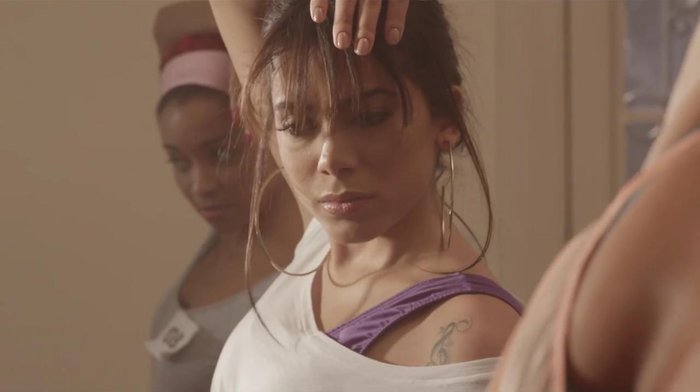By 2014, Anitta had already proven she was more than a passing trend in Brazilian pop. After the massive success of “Show das Poderosas” in 2013 and the growing recognition that followed, she stood at a crossroads. She could stay in the same lane or take things to the next level. With “Na Batida,” she made her choice clear.
This wasn’t just another fun single with a catchy chorus. “Na Batida” marked a shift. The sound was more polished. The production was tighter. And the music video became a fan-favorite at the time.
Filmed in July 2014, the “Na Batida” video was shot at the Palácio dos Cedros, one of the most striking architectural sites in São Paulo. The location brought a glamour that contrasted with the song’s modern funk-pop energy. Anitta and her team filmed late into the night, wrapping around 3 in the morning, showing just how committed she was to getting everything right.
Anitta co-wrote the video’s concept herself. She wanted it to feel dynamic, layered, and unpredictable. Her goal was to show multiple versions of herself in one clip. Not as a gimmick, but as a way to reflect how much she had grown as an artist, and how many sides of her personality had helped shape her career.
The project was directed by Fred Ouro Preto and produced by Conspiração Filmes, a respected production company known for bringing a cinematic touch to music videos. Her styling team, led by Yan Acioli, pulled off four completely different looks for Anitta. Hair and makeup were handled by Sandro Brizo and Thiago Fortes, who worked through the night alongside her.

The video is divided into four main scenes, each offering a different version of Anitta.
In one, she dances in a ballet studio, clearly inspired by the 1983 film Flashdance. She wears a simple leotard, leg warmers, and natural makeup. The room is empty except for her, and the choreography is precise but raw. It is a nod to discipline, to training, to the years she spent getting to this point.
Another scene shows her in a high-energy press conference, dressed in a bold outfit with bright colors and exaggerated accessories. This version of Anitta plays with the media and commands attention. She seems larger than life, but in control of her image. Here, the video comments on the relationship between fame and performance, where nothing is entirely real, yet everything is intensely public.
Then there is the dinner party scene. She appears dressed in a glamorous evening gown, moving through a lavish dining room filled with well-dressed guests. The tone here is slower, sultrier. She is magnetic in a way that feels more mature, more aware of her power.
Finally, the last scene brings her back to the streets, where it all started. She joins a funk street party, wearing a bold wig and surrounded by dancers. This version of Anitta is wild and free. The colors pop, the music takes over, and the choreography explodes. It is fun, raw, and completely authentic.
These scenes are not random. Together, they show a woman who is aware of how the world sees her but refuses to be boxed in. She moves between glamour and grit, between polished and street, between control and chaos. It is a reflection of her career at that moment.
The video also includes a mini storyline that adds a touch of humor and drama. In a brief but memorable moment, Anitta’s character discovers that a rival has let the air out of her tire in an attempt to sabotage her. But instead of reacting with anger, she turns the moment around. In the final scene, she rides off on a motorcycle with the rival’s boyfriend, leaving the other girl behind. It is a simple, cheeky moment that reinforces Anitta’s confidence and playfulness.
Before the video even dropped, Anitta’s team came up with a clever marketing strategy. They challenged fans on Twitter to tweet the hashtag #AnittaNaBatida 500,000 times. If they hit the target, the video would be released. Fans hit the goal in under a day. It was a perfect example of how Anitta knew how to blend traditional media with fan engagement.
The video premiered on July 29, 2014, and quickly became one of her most-watched releases. Within 24 hours, it had already passed the 1 million view mark. Over time, it racked up over 100 million views and cemented itself as one of the standout visuals from her early career.
Musically, “Na Batida” blends funk carioca with a more radio-friendly pop beat. Produced by Umberto Tavares and Jefferson Junior, the song keeps a fast tempo that matches the energy of the video. It comes from her second studio album Ritmo Perfeito, which leaned more into pop-funk fusion and showcased her as a more refined artist.
It is also worth noting that “Na Batida” came before her full pivot to international music. At the time, she was still working primarily in Portuguese and focused on Brazil. But even then, you could see the seeds being planted.
After “Na Batida,” everything began to shift. Her next release, “Deixa Ele Sofrer,” would lean into vintage American aesthetics and English-language styling. Soon after, she would start working with international artists, drop songs in Spanish and English, and become the global star we know today.
Watch now:









Leave a Reply